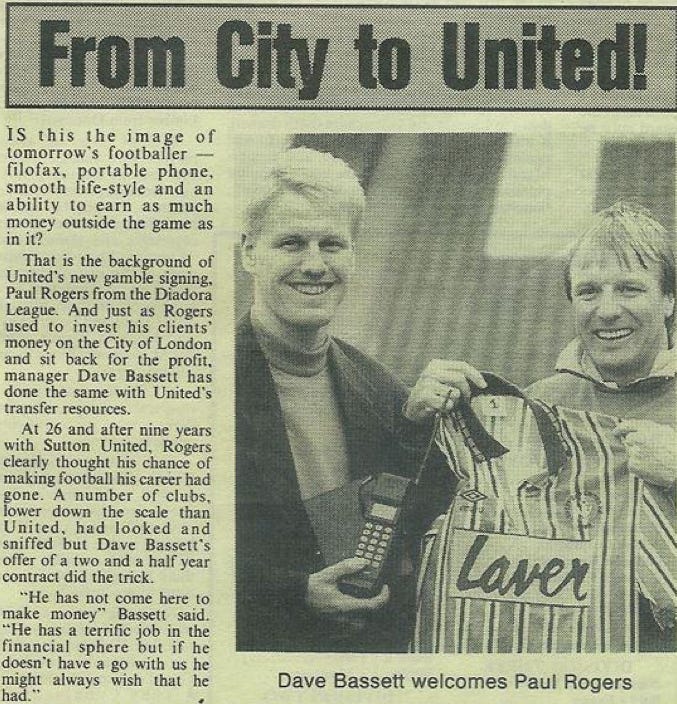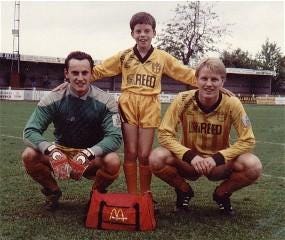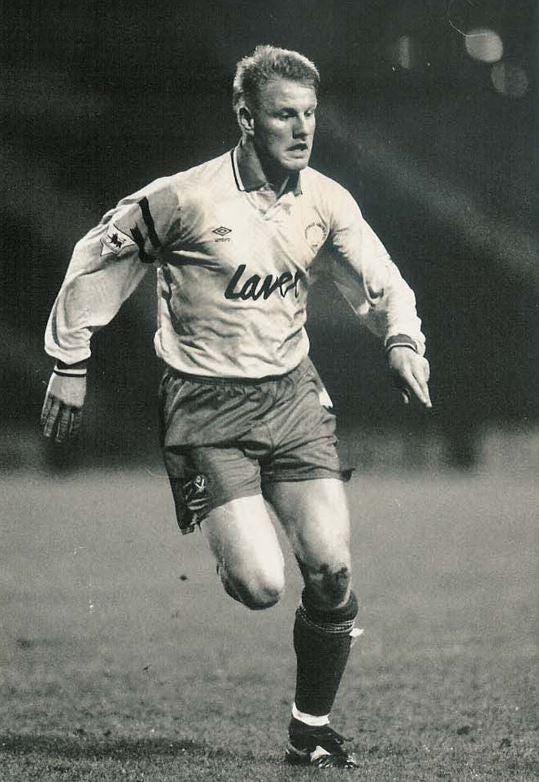Is this the image of tomorrow's footballer?
Matthew Bell investigates the curious case of Paul Rogers
But first, The Pinch recommends…
Today’s article coincides with the launch of ‘The EFL Newsletter’ by Not The Top 20. George Elek and Ali Maxwell’s podcast has long been a beacon for fans supporting clubs outside the top tier, and now they’re turning their talents textwards. We think you might like it. It’s on Substack. Give it a whirl 👇
Elsewhere, you might have clocked Rich Laverty’s work before (he’s the media officer for Sheffield United Women and Sheffield United Academy). He’s also a journalist who’s covered women’s football for the Guardian, Times, Independent… and now he’s launched the ‘Women’s Football Chronicles’ on Substack. It’s superb - check it out 👇
The curious case of Paul Rogers
Words: Matthew Bell
Imagine for a moment that during the January transfer window a mid-table Premier League club signed a 26-year-old midfield player from a National League South team and within a month he was playing regularly in the first team. Unlikely? Of course it is, and for several reasons.
Premier League clubs simply don’t sign players from clubs below the Championship any more, especially when they’re in their mid-twenties. A 17- or 18-year-old maybe, but even then he would sit in the reserves, perhaps be loaned out to lower league teams. And only when he was considered ready would he possibly form part of his club’s thirty-man squad and get an occasional look-in from the bench or a start in the League Cup.
Today, Premier League clubs want ready-made players for whom they either pay tens of millions of pounds or bring them in for nothing on short-term or loan deals. A Premier League club signing a second-tier non-league player to go straight into the first team? Never!
“He has not come here to make money.”
Well, it happened in January 1992 when Sheffield United, just below mid-table in the top division (OK, it wasn’t the Premier League then, but it would be in another eight months) bought 26-year-old Paul Rogers from Sutton United, who that season would go on to finish in the top half of what was then the Diadora League. Rogers made his debut for the Blades a few weeks later and stayed in the team for most of the rest of the season.
Rogers had played in Sutton’s famous FA Cup victory over 1987 cup winners Coventry City in January 1989. At that time Sutton were high up in the Conference, but they slipped down to relegation soon afterwards and were now rebuilding the team, trying to win promotion back to the Conference. During that Coventry game Rogers sported a floppy blond basin haircut. Now he was bleached and swept back. Apart from a dramatic change of hairstyle, it was also a dramatic change of career for Rogers, who previously earned big money in the City of London and was actually taking a pay cut to try to make it in top-level football.
Dave Bassett said:
He has not come here to make money. He has a terrific job in the financial sphere but if he doesn’t have a go with us he might always wish that he had.
Rogers added:
I worked for a firm of commodity brokers and we invested clients’ money in the stock market, financial futures. You know the scene – lots of TV monitors and people shouting their heads off. I have handed in my notice because I always wanted to be a pro. To be paid for something you really enjoy doing is surely everyone’s aim in life. I am taking the plunge now because this is the best offer I have had. I had not met Mr Bassett before but I know a few of the other lads such as John Gannon and Glyn Hodges and I used to play against Brian Gayle when he turned out for Croydon reserves.
When Rogers joined United, the Blades were in the midst of a great goalscoring spell, which included 4-2 victories over Southampton and Manchester City and a 5-2 win at Nottingham Forest. Star of the show was midfielder Mike Lake, who was enjoying one of those rare periods in a career when the ball flies into the net no matter from where on the pitch you hit it. But Lake’s halcyon days were short-lived as he never reached these heights again. When Lake suffered a knee injury, Dave Bassett decided the time was right to introduce Rogers, who had played a mere handful of reserve games, instead of restoring the reliable but unspectacular Jamie Hoyland to the side.
Bassett hoodwinked everybody, fans and press alike, by not even naming Rogers in the squad to travel to Luton Town in order to keep the new man out of the spotlight. Rogers’ debut signalled the end of United’s good run but it was hardly his fault as a rare howler by keeper Simon Tracey handed Luton their win. After the defeat Bassett paraphrased an expression originally used by Jack Charlton:
I may have lost a match but I have found a player.
A few weeks later United visited Hillsborough to play title-chasing (really – they finished third that season) Sheffield Wednesday and there was talk of lifelong Unitedite Hoyland returning as he knew well the pressures of a Sheffield derby. Hoyland had been born and brought up in the city. He had also starred in United’s 2-0 upset win over Wednesday the previous November. But no, Bassett stuck with Rogers, whose all-action display underpinned another shock victory for the Blades, as an early goal by Dane Whitehouse and two more by Bobby Davison brought a 3-1 win. Rogers had slotted into top-flight football so seamlessly that casual observers and experts alike found it hard to believe that less than two months earlier he had been playing football five levels below his current status.
Rogers stayed with United for almost four years and proved himself to be a strong-running player who had the knack of arriving late in the penalty area to score, such as his goal in the famous 6-0 win over Tottenham Hotspur in February 1993. He had come from a relative nowhere but straightaway compared favourably with all but the very best midfielders in the division. Whether this says more about Paul Rogers or the quality of English football during the period 1992-94.
A year or so later United signed another player, Andy Scott, from Sutton United and neither did he look out of place. This was because English football was going through a state of depression in the early 1990s. This was before the advent of multi-million-pound-earning footballers (the Sky TV revolution was a few months away in early 1992) and the proliferation of world-class foreign stars. It was also the time when England performed dismally at Euro 1992 in Sweden and subsequently failed to qualify for the 1994 World Cup in the USA. It was when Geoff Thomas and Carlton Palmer were two of the finest midfielders in England, and when Sheffield Wednesday were the third-best team in the land. Enough said.
Paul Rogers went on to have a lengthy Football League career at Notts County, Wigan Athletic and, in particular, Brighton and Hove Albion (all then lower division teams), but today Leagues One and Two would probably have been the limit of his talents. Could a player from the National League South step in and make an immediate impact in the Premier League today? Not much chance, and I doubt if any club would even dare to try.
Matthew Bell was editor of Sheffield United fanzine Flashing Blade from 1989 to 2019 and wrote a weekly column for the Green ‘Un and Sheffield Star newspapers between 1993 and 2015. He has also published several books on local history and the social history of sport.








Great piece Matthew, Dave Bassett was unbelievable, the Paul Rogers signing and mention of the Bobby Davison/Whitehouse goals. think Chis Woods had a nightmare, Brilliant memories.
Thanks, Matthew
Interesting article – and thanks for the links to the EFL Newsletter and Rich Laverty’s Chronicles; they look like more interesting reading.
Obviously like any other line of work, football has changed immeasurably over the last 30 years (phone like a brick and Filofax *grin*!) but this really does highlight the dichotomy between the attitudes of ‘then’ and ‘now’. And how refreshing that a player came not for the money, but just to play football! (Before my time supporting I'm afraid, but it would have been great to see Paul Rogers in action).
“It was when Geoff Thomas and Carlton Palmer were two of the finest midfielders in England, and when Sheffield Wednesday were the third-best team in the land. Enough said.”
‘nuff said indeed!
Sue.